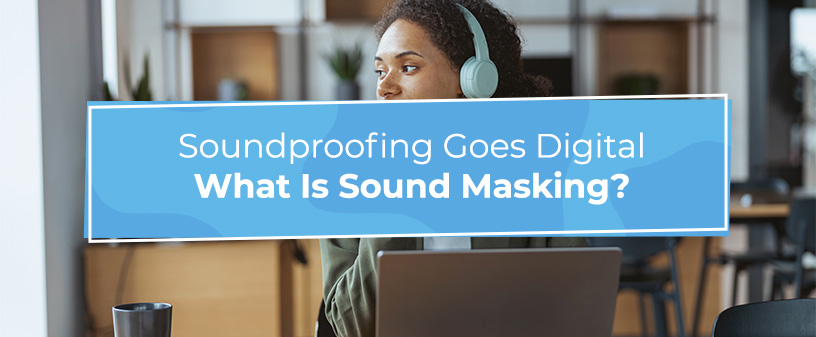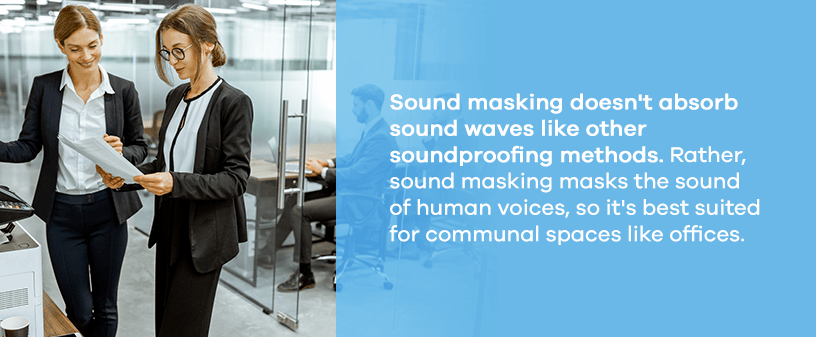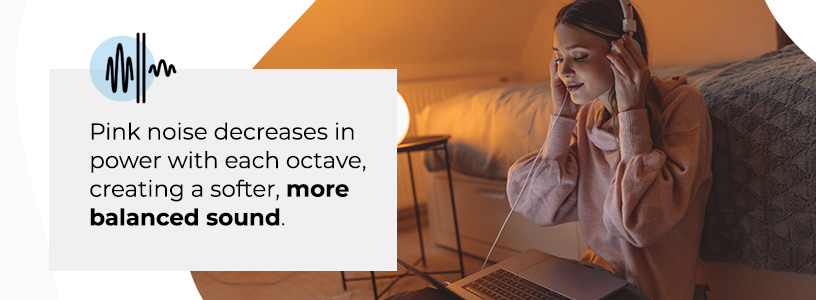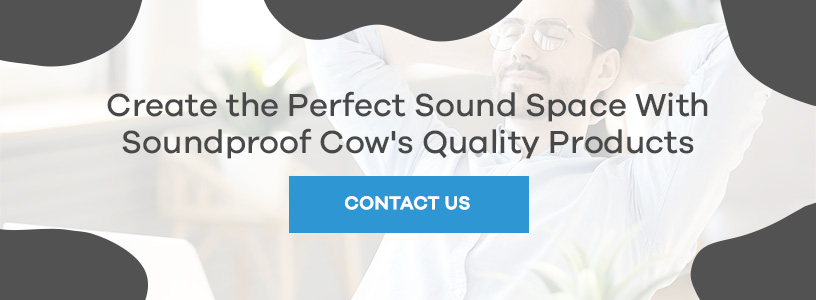
Table of Contents:
What Is Sound Masking
How Does Sound Masking Work
Benefits of Sound Masking
Color Noises for Masking Sound
How Are Sound Masking and White Noise Different?
Sound masking is a technique using background sound to hide more distracting noise. Imagine you are in your favorite coffee shop during the morning rush. The combination of conversation and machine whirring should be deafening. Instead, a soothing background buzz somehow makes all the chatter around you disappear.
That is similar to what sound masking does in an office. It slips in an airflow-like sound to dim keyboard clacks and loud conversations. It is like turning down the volume on distracting noises without realizing it. The result is a more private space that lets you focus without all that noise competing for your attention.
Sound masking systems benefit open floorplan offices, hospitals, and academic institutions. This go-to guide covers everything you need to know about this digital form of soundproofing.
What Is Sound Masking?
Sound masking introduces ambient noise to match human speech frequencies, which are between 500 and 4,000 hertz. The types of sound used in masking need to meet specific criteria:
- Random: The brain attaches meaning to certain sounds, like a car engine revving. Masking uses neutral sounds that the human ear does not recognize. By using random noise, it makes it easier to ignore.
- Wide frequency range: Disruptive noises span a wide range of frequencies. The sound used in masking must cover an equally large spectrum.
How Does Sound Masking Work?
Think of sound masking as an audio invisibility cloak. Instead of eliminating noise, it disguises it to be less noticeable. Here is how it pulls off this trick of the ear:
- Adds background noise: A subtle sound like constant airflow acts as camouflage. You should hear but not notice the sound as it blends into the background.
- Masks distractions: Human speech can be distracting in areas like open floorplan offices. Noise masking fills gaps in the sound spectrum to make talking less distinct. Imagine trying to make out a conversation when you are underwater. You may hear the tone but not the words.
- Tunes into the environment: Sound masking systems consider the surrounding acoustics. You can adjust the frequency and volume to suit the space. By fine-tuning, you can hide unwanted noise without the masking sound becoming disruptive.
- Uses speaker technology: Speakers placed at strategic points ensure even sound distribution. The placement and number of speakers depend on the space size, layout and type of noise you want to mask.
What Are the Benefits of Sound Masking in the Workplace?
Distracting sounds can impact productivity in offices or other work environments — focusing on a budget report is challenging when you can hear a co-worker chatting about their recent vacation. Here are five advantages of masking sound in the workplace:
- Enhances privacy: Many organizations handle sensitive or confidential information. Noise masking prevents overhearing conversations by making speech harder to understand.
- Increases productivity: Fewer distractions mean greater focus. Efficiency soars when employees can concentrate on their work without disruptive noise.
- Promotes comfort: Annoying sounds can create a stressful environment. Masking in sound provides soothing ambient noise to create a more comfortable working environment.
- Reduces error: Distractions can lead to mistakes, which can be damaging to businesses. Masking may decrease error risk by limiting disruptive noises.
- Improved employee satisfaction: Improving the acoustic environment can have a positive effect on job satisfaction. For example, research shows a correlation between workplace noise exposure and quality of life among nurses. According to the study, those with noisier work environments had increased burnout and stress levels.
What Are Color Noises for Masking Sound?
Sounds come in many “colors” that target specific frequencies. These different colors refer to how energy disperses across frequencies. Each color creates a unique soundscape for a particular purpose, such as relaxation or concentration.
1. White Noise
White noise combines sounds from all audible frequencies.
- Equal intensity: High, mid and low tones exist at the same level. An even distribution of frequencies creates a consistent sound.
- Sound: White noise sounds like a constant hiss or TV static.
- Masking abilities: White noise can be helpful in masking sound since it covers a wide range of frequencies.
- Use cases: This color noise works for sleep, meditation, relaxation, and is soothing.
2. Brown Noise
Brown noise has more energy at lower frequencies. A phenomenon called “Brownian motion” refers to the random movement of particles suspended in a liquid. Sound signals in brown noise mimic this movement.
- Lower frequencies: Brown noise lives at the lower end of the sound spectrum. Sound energy decreases as frequency increases, so higher frequencies have less energy.
- Sound: Some compare brown noise to rumbling thunder or rolling ocean waves. It produces a rich sound for a calming effect.
- Masking abilities: Due to its low-frequency focus, brown noise masks machinery or urban noises.
- Use cases: Brown noise is less intrusive than white noise. It suits relaxation and sleep therapy or masks lower-frequency sounds.
3. Pink Noise
Pink and white noise are similar but differ in frequency distribution. Pink noise decreases in power with each octave, creating a softer, more balanced sound. Here are the key characteristics of pink noise:
- Octave distribution: Pink noise has equal energy distribution across octaves. Higher frequencies are less intense and harsh than white noise.
- Sound: Pink noise mimics sounds found in nature. Think of falling rain, wind rustling leaves or the steady flow of a river. Its organic sound makes it more soothing than white noise.
- Masking abilities: Since it blends with the environment, pink noise offers natural sound masking.
- Use cases: The balanced energy distribution is useful for improved sleep and concentration.
4. Blue Noise
Blue or azure noise concentrates its energy at the high end of the frequency spectrum. Unlike pink or white noise, blue noise has more energy at higher frequencies and less at lower frequencies. Although used in audio engineering, blue noise is ineffective at masking sound. Its high-pitched frequency can be uncomfortable for the human ear.
5. Gray Noise
Gray noise is less well-known than the other types of sound. It is a flat sound designed for uniform loudness across all frequencies. This noise accommodates hearing sensitivity and is best suited for audio calibration applications. Gray noise can cover consistent background noise without any volume variation.
How Are Sound Masking and White Noise Different?
People often confuse sound masking with white noise. Although both use frequencies to cover sound, they do it differently. It is like comparing a Holstein and a Texas Longhorn. Sure, they are both cow breeds, but they have characteristics that make them unique.
Let us break down the differences between these two techniques:
- Sound masking: Engineered sounds target the frequencies of conversations to make speech less intelligible. It allows customization for the acoustics of a specific environment. Masking suits professional applications like offices, call centers or meeting rooms. Systems include speakers and sound generators.
- White noise: White noise involves a consistent, static-like sound covering a broad frequency range. White noise masks all sound types without focusing on human speech. It works well for more general applications like aiding sleep or concentration.
White noise is a broader solution for background noise. Sound masking provides a targeted solution to maintain privacy and limit noise distraction.
Create the Perfect Sound Space With Soundproof Cow’s Quality Products
Soundproof Cow helps customers create the ideal environment using our sound-savvy materials. Our top-quality soundproofing products enhance privacy and reduce unwanted sound within a space. You can also check out our cutting-edge sound absorption materials to reduce echo and improve audio quality.
Trust our expert team to recommend the perfect sound solution for your needs! Give us a call at 866-949-9269 or contact us online and let us wow you with our expertise and service.
Learn More About Understanding Sound
What is Reverberation of Sound
Impact Noise vs Airborne Noise










